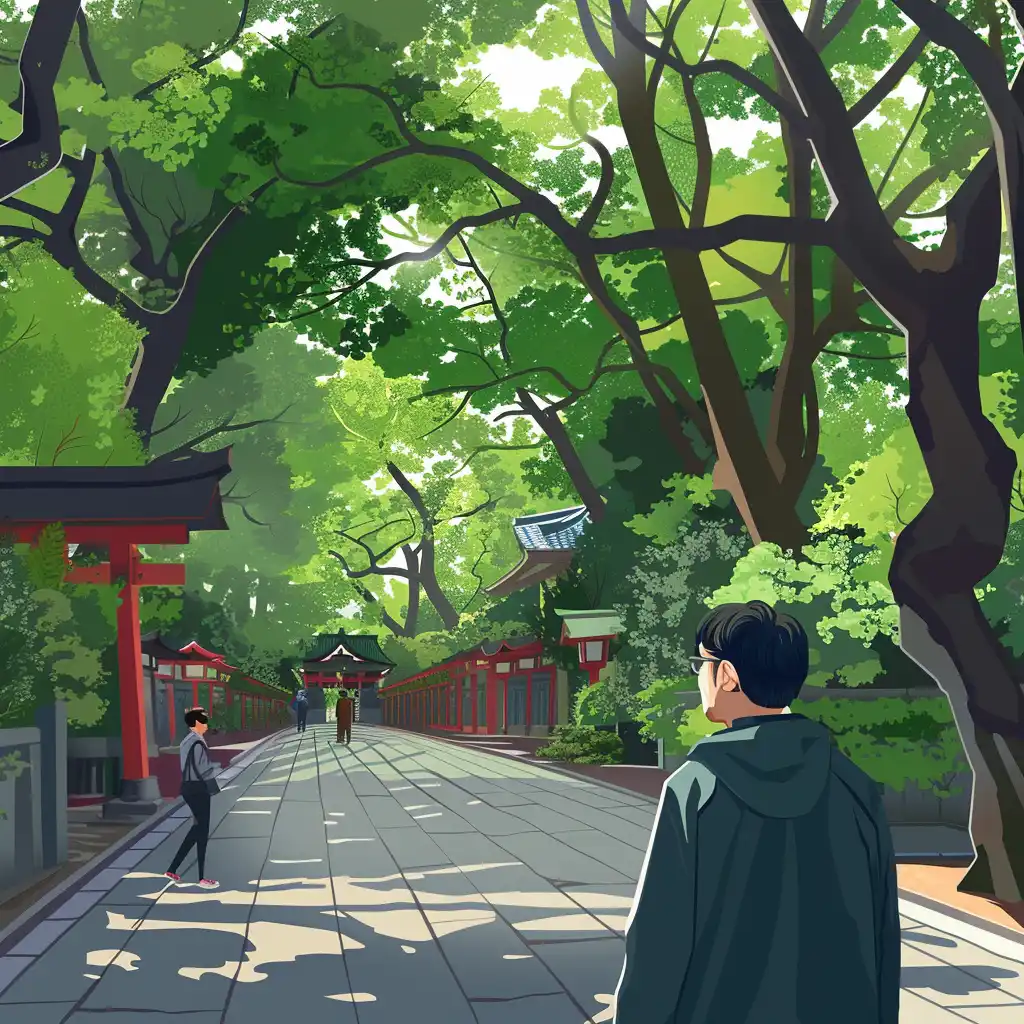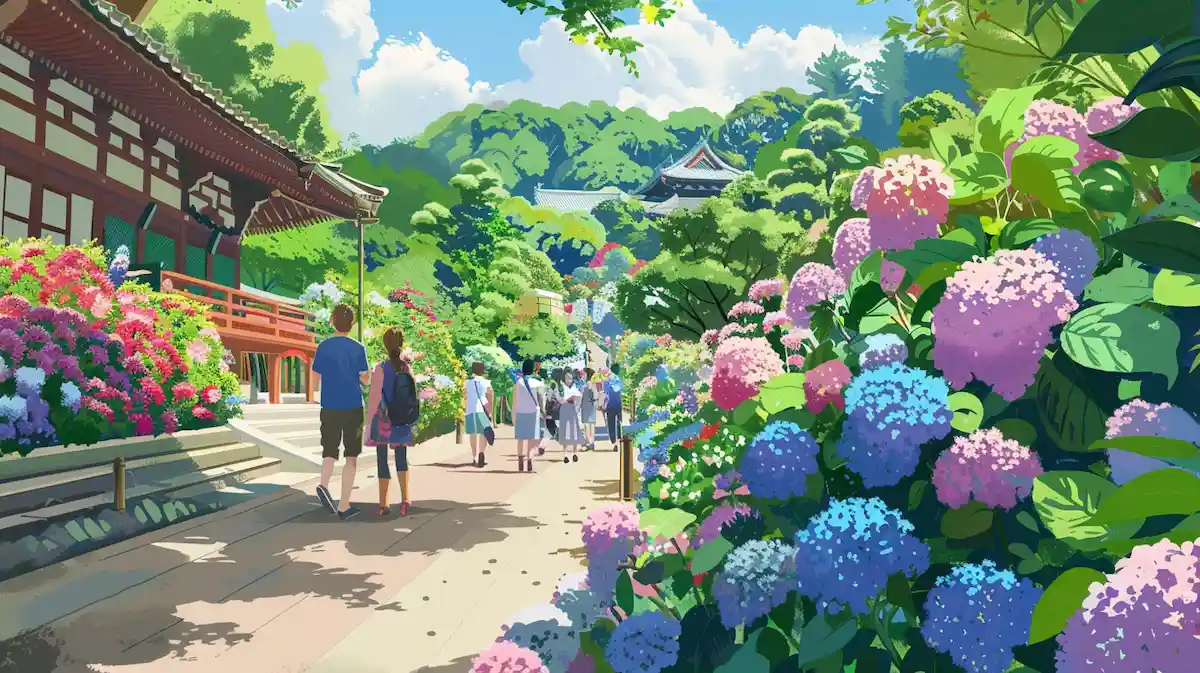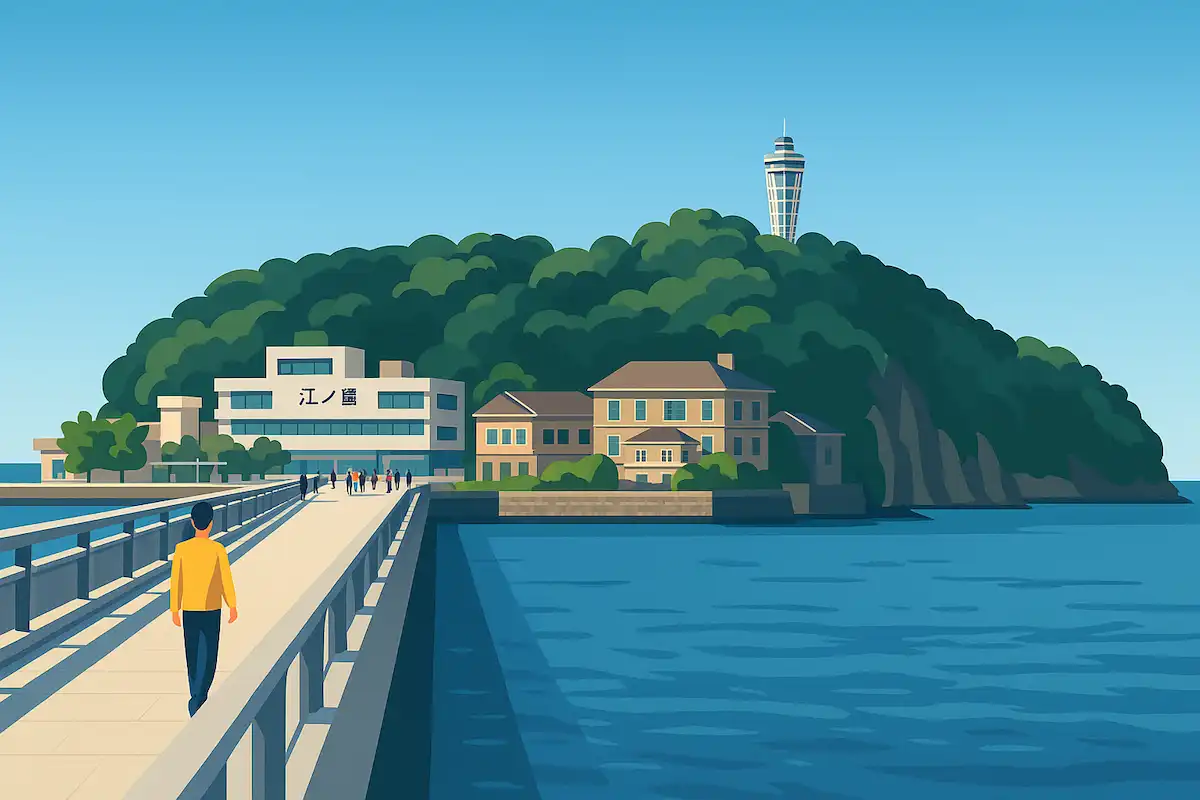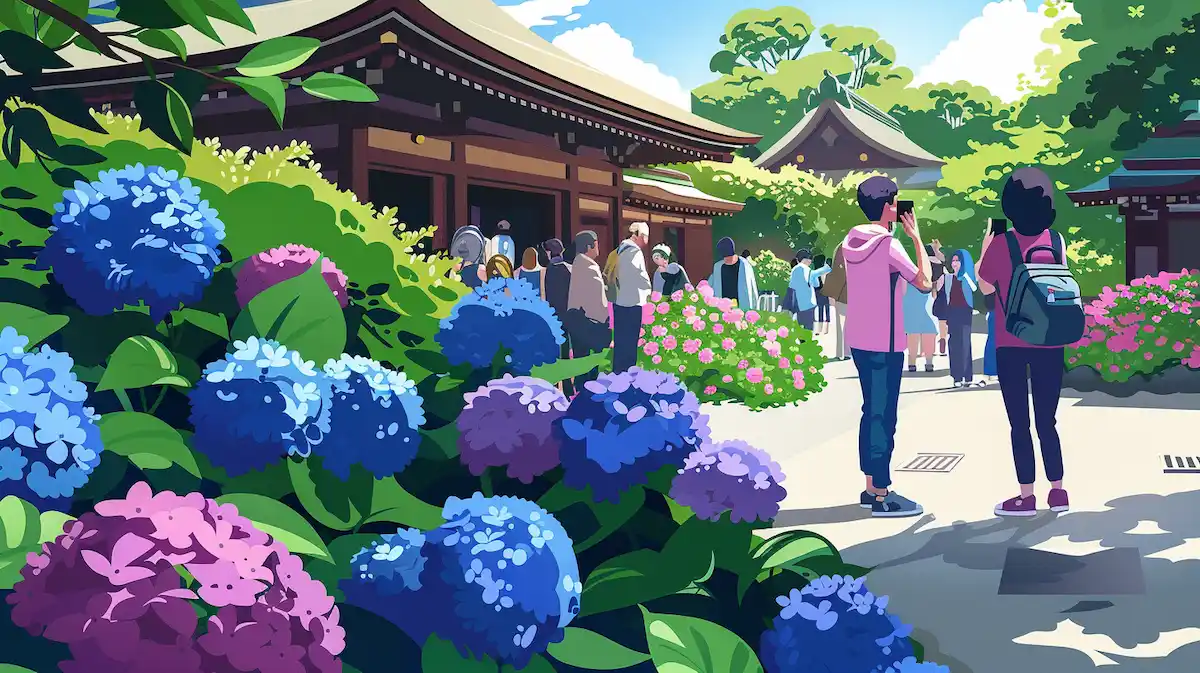明月院を英語で説明・紹介するための基本情報と、英会話に役立つ表現をシンプルでわかりやすい英語で紹介します。
英会話ダイアローグ・関連情報・10の質問を通して、明月院に関する英語表現を学びます。
英語
英会話ダイアローグを読む前に知っておくと良い前提知識と情報は以下の通りです。
- 歴史
- 明月院は1160年に創建され、臨済宗円覚寺派に属する寺院
- あじさいの名所
- 「あじさい寺」として知られており、6月には庭園は美しい青や紫のあじさいで満たされる
- このあじさいは「明月院ブルー」と呼ばれている
- 寺院内の特徴
- 本堂の「悟りの窓」は、庭園の美しい景色を楽しむことができ、宇宙や生命の循環を象徴
- 境内には静かな竹林もある
- アクセス
- 明月院はJR横須賀線の北鎌倉駅から徒歩約10分
2人が明月院について話しています。
明月院のあじさいが「明月院ブルー」として知られていること、庭園の美しさ、竹林、「悟りの窓」などの特徴を話題にしています。
アクセス方法や訪れるのに最適な時期についても触れています。
会話 / dialogue

Hey Key, I’ve been really interested in visiting Meigetsu-in. Have you heard about it?

Yes, I have! Meigetsu-in is quite famous, especially in June. They call it the “Hydrangea Temple,” right?

Exactly! I read that the hydrangeas there are amazing. They even have a special name, “Meigetsu-in Blue,” because of their beautiful blue color.

That sounds wonderful. June must be the best time to visit then.

Yes, it is. The garden is filled with these blue and purple hydrangeas. I really want to see that.

Besides the hydrangeas, what else is there to see at Meigetsu-in?

The temple has a beautiful garden that looks great in every season. In spring, there are cherry blossoms, in autumn, the leaves change colors, and in winter, the snow-covered garden is very pretty.

That’s good to know. I love gardens that change with the seasons. Do they have anything unique inside the temple?

Yes, the main hall has some important cultural items like old statues and scrolls. There’s also a round window called the “Window of Enlightenment” that gives a beautiful view of the garden.

I’ve heard about that window. It’s supposed to represent the universe and the cycle of life, right?

Yes, exactly. It’s quite symbolic and peaceful. Also, there’s a bamboo grove in the temple grounds, which adds to the serene atmosphere.

That sounds like a perfect place for a peaceful walk. How do you get there?

It’s quite convenient. You can walk about 10 minutes from Kita-Kamakura Station on the JR Yokosuka Line.

Great! That’s not too far. Maybe we can plan a visit next month. I’d love to see the “Meigetsu-in Blue” hydrangeas myself.

I’d love that too. I’ve been looking forward to experiencing the beauty of Meigetsu-in and taking some photos.

Yes, I’ve seen some photos online, and they’re stunning. Visiting in June seems like the perfect plan.

Definitely. Plus, we can explore the other features of the temple and enjoy the peaceful environment.

Agreed. Let’s make a plan to go. I’m sure it will be a memorable experience.

Sounds good. I can’t wait to see the hydrangeas and the beautiful garden.

Me neither. It’s going to be a great trip!
関連情報 / related information
「明月院」について、理解を深めるための「英語での関連情報」です。
明月院

Location and History
Meigetsu-in is a temple located in Kamakura, Kanagawa Prefecture, Japan. It was founded in 1160 and is part of the Rinzai Zen sect. The temple has a long history and is known for its beautiful and peaceful surroundings.
Famous for Hydrangeas
Meigetsu-in is most famous for its hydrangea flowers. In June, the garden is filled with blue and purple hydrangeas, which are called “Meigetsu-in Blue.” Many people visit the temple during this time to see the beautiful flowers. The hydrangeas make the temple a popular spot in the rainy season.
Beautiful Garden
The temple’s garden is beautiful in every season. In spring, you can see cherry blossoms. In autumn, the leaves change colors and create a stunning view. In winter, the garden looks serene with snow. The garden’s changing beauty attracts many visitors throughout the year.
Temple Features
Inside the temple, there are important cultural items like old statues and scrolls. The main hall has a round window called the “Window of Enlightenment.” This window offers a beautiful view of the garden and symbolizes the universe and the cycle of life. The temple grounds also have a quiet bamboo grove, adding to the peaceful atmosphere.
Access
Meigetsu-in is easy to reach. It is about a 10-minute walk from Kita-Kamakura Station on the JR Yokosuka Line. The convenient location makes it easy for visitors to explore other parts of Kamakura as well.
10の質問 / 10 questions
「明月院」について、理解を深めるための「英語での10の質問」です。
1: What is Meigetsu-in?
Meigetsu-in is a Buddhist temple located in Kamakura, Japan. It is known for its beautiful hydrangea flowers and peaceful garden.
2: Why is Meigetsu-in called the "Hydrangea Temple"?
Meigetsu-in is called the "Hydrangea Temple" because it has many hydrangea flowers that bloom in June, covering the garden in blue and purple.
3: When is the best time to visit Meigetsu-in?
The best time to visit Meigetsu-in is in June, during the rainy season, when the hydrangeas are in full bloom.
4: What is the "Window of Enlightenment" at Meigetsu-in?
The "Window of Enlightenment" is a round window in the main hall that offers a beautiful view of the garden and symbolizes the universe and life’s cycle.
5: How can I get to Meigetsu-in?
You can reach Meigetsu-in by walking about 10 minutes from Kita-Kamakura Station on the JR Yokosuka Line.
6: What other features can be seen at Meigetsu-in besides hydrangeas?
Meigetsu-in also has a serene bamboo grove, a peaceful garden, and important cultural items like old statues and scrolls.
7: What makes the hydrangeas at Meigetsu-in special?
The hydrangeas at Meigetsu-in are called "Meigetsu-in Blue" because of their striking blue color, which is especially beautiful in the rainy season.
8: Can I visit Meigetsu-in in other seasons?
Yes, Meigetsu-in is beautiful in all seasons. In spring, there are cherry blossoms, in autumn, the leaves change colors, and in winter, the garden is peaceful with snow.
9: What kind of temple is Meigetsu-in?
Meigetsu-in is a Rinzai Zen temple, which is part of the Rinzai school of Japanese Zen Buddhism.
10: Why do people visit Meigetsu-in?
People visit Meigetsu-in to enjoy its beautiful garden, see the hydrangeas in June, and experience the peaceful atmosphere of the temple grounds.
和訳付
会話 / dialogue

Hey Key, I’ve been really interested in visiting Meigetsu-in. Have you heard about it?
キー、最近明月院に行きたいと思っているんだ。知っている?

Yes, I have! Meigetsu-in is quite famous, especially in June. They call it the “Hydrangea Temple,” right?
うん、知っているよ!明月院は特に6月に有名だよね。「あじさい寺」とも呼ばれているんだよね?

Exactly! I read that the hydrangeas there are amazing. They even have a special name, “Meigetsu-in Blue,” because of their beautiful blue color.
その通り!あそこのあじさいは素晴らしいと読んだよ。美しい青色だから「明月院ブルー」と呼ばれているんだ。

That sounds wonderful. June must be the best time to visit then.
それは素敵だね。じゃあ、6月が訪れるのに最適な時期なんだね。

Yes, it is. The garden is filled with these blue and purple hydrangeas. I really want to see that.
そうだよ。庭は青や紫のあじさいでいっぱいになるんだ。ぜひ見たいな。

Besides the hydrangeas, what else is there to see at Meigetsu-in?
あじさいの他に、明月院には何があるの?

The temple has a beautiful garden that looks great in every season. In spring, there are cherry blossoms, in autumn, the leaves change colors, and in winter, the snow-covered garden is very pretty.
寺院には四季折々の美しい庭園があるんだ。春には桜が咲き、秋には紅葉があり、冬には雪に覆われた庭園がとても綺麗なんだ。

That’s good to know. I love gardens that change with the seasons. Do they have anything unique inside the temple?
それはいいね。季節によって変わる庭園が好きなんだ。寺院の中には何か特別なものがあるの?

Yes, the main hall has some important cultural items like old statues and scrolls. There’s also a round window called the “Window of Enlightenment” that gives a beautiful view of the garden.
うん、本堂には古い仏像や掛け軸などの重要な文化財があるよ。「悟りの窓」と呼ばれる円窓からは美しい庭園が見えるんだ。

I’ve heard about that window. It’s supposed to represent the universe and the cycle of life, right?
その窓のことは聞いたことがあるよ。それは宇宙や生命の循環を象徴しているんだよね?

Yes, exactly. It’s quite symbolic and peaceful. Also, there’s a bamboo grove in the temple grounds, which adds to the serene atmosphere.
そうだよ。その通り。とても象徴的で平和的なんだ。また、寺院の敷地内には竹林もあって、静かな雰囲気をさらに高めているよ。

That sounds like a perfect place for a peaceful walk. How do you get there?
それは静かな散歩にぴったりの場所だね。どうやって行くの?

It’s quite convenient. You can walk about 10 minutes from Kita-Kamakura Station on the JR Yokosuka Line.
とても便利だよ。JR横須賀線の北鎌倉駅から歩いて約10分で行けるよ。

Great! That’s not too far. Maybe we can plan a visit next month. I’d love to see the “Meigetsu-in Blue” hydrangeas myself.
いいね!それほど遠くないね。来月訪れる計画を立てようか。「明月院ブルー」のあじさいを自分の目で見たいな。

I’d love that too. I’ve been looking forward to experiencing the beauty of Meigetsu-in and taking some photos.
僕もそれは楽しみだよ。明月院の美しさを体験して、写真を撮りたいんだ。

Yes, I’ve seen some photos online, and they’re stunning. Visiting in June seems like the perfect plan.
うん、オンラインで写真を見たけど、本当に素晴らしいよね。6月に訪れるのが最高の計画だね。

Definitely. Plus, we can explore the other features of the temple and enjoy the peaceful environment.
間違いないね。それに、寺院の他の特徴も探検して、静かな環境を楽しもう。

Agreed. Let’s make a plan to go. I’m sure it will be a memorable experience.
同感だよ。計画を立てよう。きっと忘れられない体験になるよ。

Sounds good. I can’t wait to see the hydrangeas and the beautiful garden.
いいね。あじさいと美しい庭園を見るのが待ちきれないよ。

Me neither. It’s going to be a great trip!
僕もだよ。素晴らしい旅行になるね!
関連情報 / related information
明月院

Location and History
Meigetsu-in is a temple located in Kamakura, Kanagawa Prefecture, Japan. It was founded in 1160 and is part of the Rinzai Zen sect. The temple has a long history and is known for its beautiful and peaceful surroundings.
明月院は、日本の神奈川県鎌倉市にある寺院です。1160年に創建され、臨済宗円覚寺派に属しています。寺院は長い歴史を持ち、美しく静かな環境で知られています。
Famous for Hydrangeas
Meigetsu-in is most famous for its hydrangea flowers. In June, the garden is filled with blue and purple hydrangeas, which are called “Meigetsu-in Blue.” Many people visit the temple during this time to see the beautiful flowers. The hydrangeas make the temple a popular spot in the rainy season.
明月院は、あじさいの花で最も有名です。6月には、庭が「明月院ブルー」と呼ばれる青や紫のあじさいでいっぱいになります。この美しい花を見るために、多くの人々がこの時期に寺院を訪れます。あじさいは、梅雨の季節に寺院を人気のスポットにしています。
Beautiful Garden
The temple’s garden is beautiful in every season. In spring, you can see cherry blossoms. In autumn, the leaves change colors and create a stunning view. In winter, the garden looks serene with snow. The garden’s changing beauty attracts many visitors throughout the year.
寺院の庭園は、四季折々の美しさを持っています。春には桜が咲き、秋には紅葉が色づいて見事な景色を作ります。冬には雪で覆われ、庭園は静寂な雰囲気になります。このように変化する庭園の美しさが、年間を通じて多くの訪問者を引きつけています。
Temple Features
Inside the temple, there are important cultural items like old statues and scrolls. The main hall has a round window called the “Window of Enlightenment.” This window offers a beautiful view of the garden and symbolizes the universe and the cycle of life. The temple grounds also have a quiet bamboo grove, adding to the peaceful atmosphere.
寺院の内部には、古い仏像や掛け軸などの重要な文化財があります。本堂には「悟りの窓」と呼ばれる円窓があり、この窓からは美しい庭園の景色が楽しめます。この窓は宇宙や生命の循環を象徴しています。寺院の敷地内には静かな竹林もあり、平和な雰囲気をさらに高めています。
Access
Meigetsu-in is easy to reach. It is about a 10-minute walk from Kita-Kamakura Station on the JR Yokosuka Line. The convenient location makes it easy for visitors to explore other parts of Kamakura as well.
明月院はアクセスが便利です。JR横須賀線の北鎌倉駅から徒歩約10分の距離にあります。この便利な場所により、訪問者は鎌倉の他の場所も簡単に探索できます。
10の質問 / 10 questions
1: What is Meigetsu-in?
明月院とは何ですか?
Meigetsu-in is a Buddhist temple located in Kamakura, Japan. It is known for its beautiful hydrangea flowers and peaceful garden.
明月院は、日本の鎌倉にある仏教寺院です。美しいあじさいの花と静かな庭園で知られています。
2: Why is Meigetsu-in called the "Hydrangea Temple"?
なぜ明月院は「あじさい寺」と呼ばれるのですか?
Meigetsu-in is called the "Hydrangea Temple" because it has many hydrangea flowers that bloom in June, covering the garden in blue and purple.
明月院は6月に多くのあじさいが咲き、庭園が青や紫に覆われるため、「あじさい寺」と呼ばれています。
3: When is the best time to visit Meigetsu-in?
明月院を訪れるのに最適な時期はいつですか?
The best time to visit Meigetsu-in is in June, during the rainy season, when the hydrangeas are in full bloom.
最適な時期は梅雨の時期である6月です。この時期にはあじさいが満開になります。
4: What is the "Window of Enlightenment" at Meigetsu-in?
明月院の「悟りの窓」とは何ですか?
The "Window of Enlightenment" is a round window in the main hall that offers a beautiful view of the garden and symbolizes the universe and life’s cycle.
「悟りの窓」は本堂にある円形の窓で、美しい庭園の景色を楽しめ、宇宙と生命の循環を象徴しています。
5: How can I get to Meigetsu-in?
明月院へのアクセス方法は?
You can reach Meigetsu-in by walking about 10 minutes from Kita-Kamakura Station on the JR Yokosuka Line.
明月院へは、JR横須賀線の北鎌倉駅から徒歩約10分で到着します。
6: What other features can be seen at Meigetsu-in besides hydrangeas?
明月院では、あじさい以外にどのような特徴がありますか?
Meigetsu-in also has a serene bamboo grove, a peaceful garden, and important cultural items like old statues and scrolls.
明月院には静かな竹林や落ち着いた庭園、古い仏像や掛け軸などの重要な文化財もあります。
7: What makes the hydrangeas at Meigetsu-in special?
明月院のあじさいは何が特別ですか?
The hydrangeas at Meigetsu-in are called "Meigetsu-in Blue" because of their striking blue color, which is especially beautiful in the rainy season.
明月院のあじさいは「明月院ブルー」と呼ばれ、その鮮やかな青色が特に梅雨の時期に美しく映えます。
8: Can I visit Meigetsu-in in other seasons?
明月院は他の季節でも訪れることができますか?
Yes, Meigetsu-in is beautiful in all seasons. In spring, there are cherry blossoms, in autumn, the leaves change colors, and in winter, the garden is peaceful with snow.
はい、明月院はどの季節でも美しいです。春には桜が咲き、秋には紅葉があり、冬には雪で静かな庭園が楽しめます。
9: What kind of temple is Meigetsu-in?
明月院はどのような寺院ですか?
Meigetsu-in is a Rinzai Zen temple, which is part of the Rinzai school of Japanese Zen Buddhism.
明月院は臨済宗の寺院で、日本の禅仏教の一派である臨済宗に属しています。
10: Why do people visit Meigetsu-in?
なぜ人々は明月院を訪れるのですか?
People visit Meigetsu-in to enjoy its beautiful garden, see the hydrangeas in June, and experience the peaceful atmosphere of the temple grounds.
人々は美しい庭園を楽しみ、6月のあじさいを見て、寺院の静かな雰囲気を体験するために明月院を訪れます。
words & phrases
英会話ダイアローグと関連情報に出てきた単語・フレーズです(例文は各3つ)。

enlightenment: 名詞
意味: 啓発、悟り。The state of gaining knowledge and understanding, especially in spiritual or intellectual matters.
(明月院の「悟りの窓」が象徴する悟りの状態を指す)
例文:
The Buddha attained enlightenment under the Bodhi tree.
「ブッダは菩提樹の下で悟りを開きました。」
Many people seek enlightenment through meditation.
「多くの人々が瞑想を通じて悟りを求めています。」
The Age of Enlightenment brought many changes to Europe.
「啓蒙時代はヨーロッパに多くの変化をもたらしました。」
grove: 名詞 /ɡroʊv/
意味: 小さな林、木立。A small group of trees, especially one near a house or in a park.
(明月院の竹林を指す)
例文:
They walked through the orange grove.
「彼らはオレンジの木立を歩きました。」
The house is surrounded by a grove of oak trees.
「その家はオークの木立に囲まれています。」
We had a picnic in the quiet grove.
「私たちは静かな木立でピクニックをしました。」
serene: 形容詞 /səˈriːn/
意味: 穏やかな、静かな。Calm, peaceful, and untroubled.
(明月院の庭園や竹林の静かな雰囲気を指す)
例文:
The lake was serene at sunrise.
「湖は日の出の時に穏やかでした。」
She looked serene and happy.
「彼女は穏やかで幸せそうに見えました。」
We enjoyed a serene afternoon in the park.
「私たちは公園で穏やかな午後を楽しみました。」
memorable: 形容詞
意味: 記憶に残る、忘れられない。Worth remembering or easily remembered, especially because of being special or unusual.
(明月院の訪問が忘れられない体験になることを指す)
例文:
It was a memorable trip to Paris.
「それはパリへの忘れられない旅行でした。」
Her speech was memorable for its powerful message.
「彼女のスピーチはその力強いメッセージで記憶に残りました。」
We had a memorable dinner at the new restaurant.
「私たちは新しいレストランで記憶に残るディナーを楽しみました。」
surroundings: 名詞
意味: 周囲の環境、周囲の状況。The things and conditions around a person or place.
(明月院の美しく静かな周囲の環境を指す)
例文:
They admired the beautiful surroundings of the countryside.
「彼らは田舎の美しい環境に感嘆しました。」
The hotel is located in peaceful surroundings.
「そのホテルは静かな環境にあります。」
The park’s surroundings make it a perfect place for a walk.
「その公園の周囲の環境は散歩に最適です。」
詳細情報 / Further Info
関連記事(鎌倉観光の魅力、長谷寺(鎌倉)、江ノ島)



